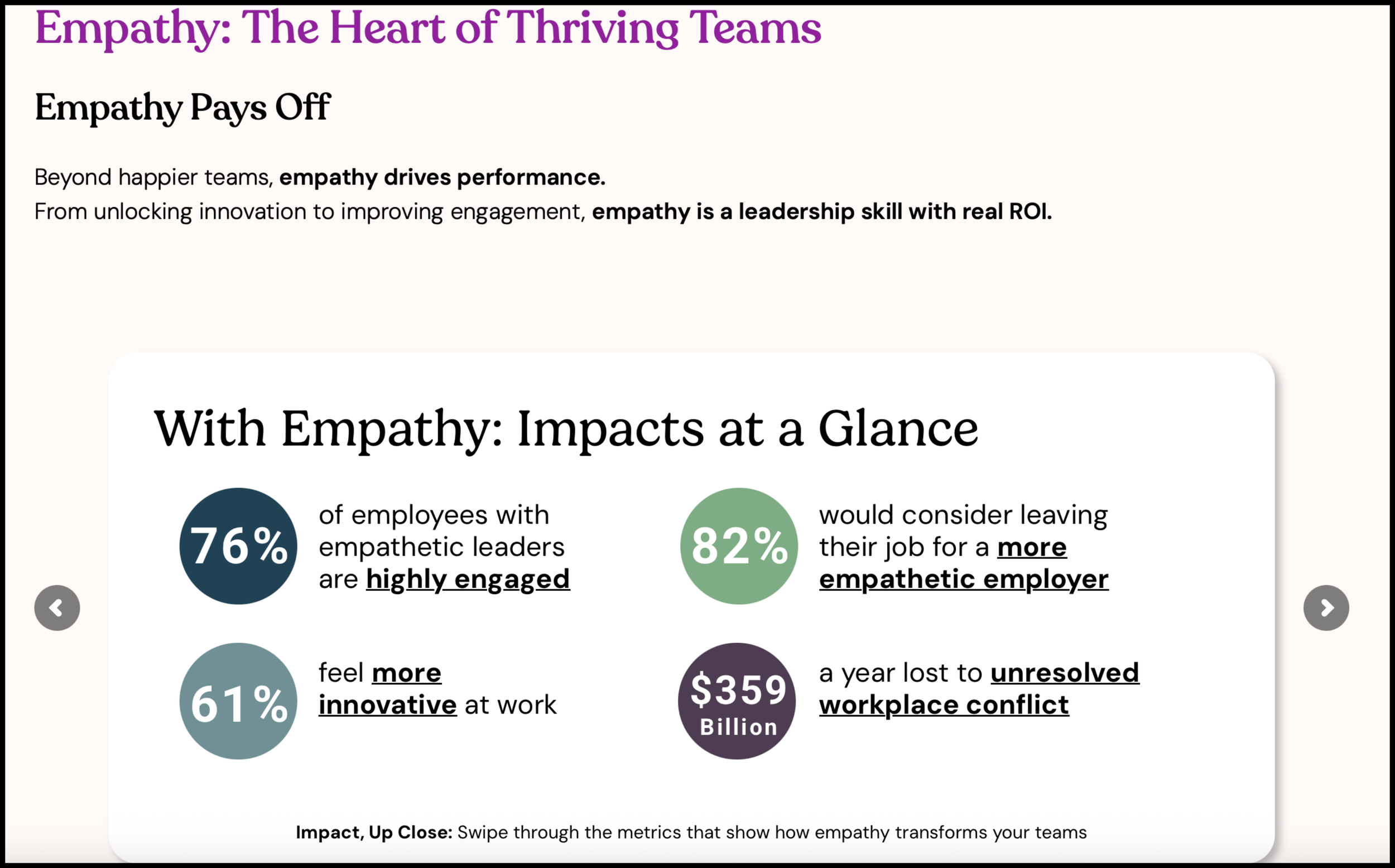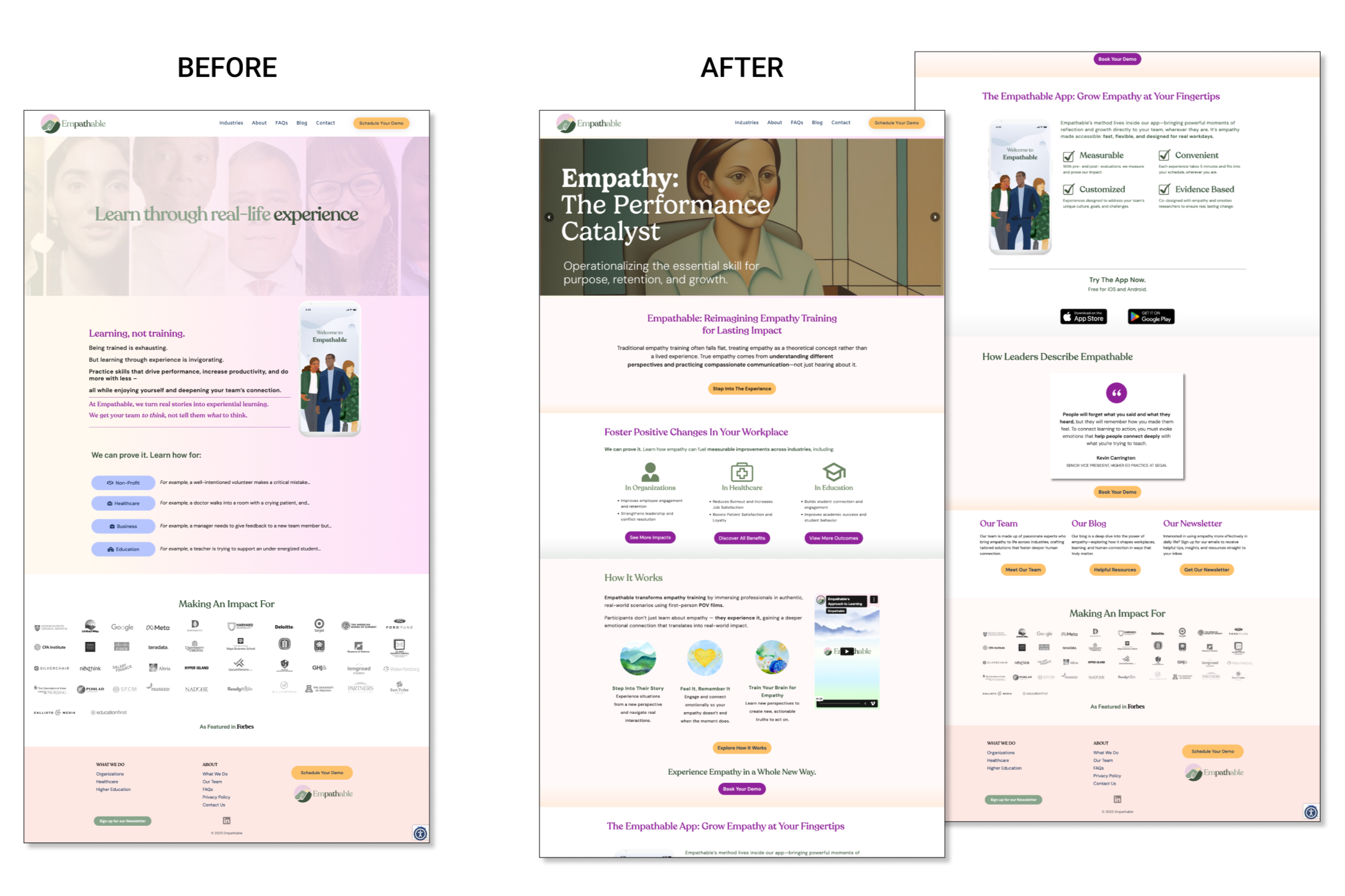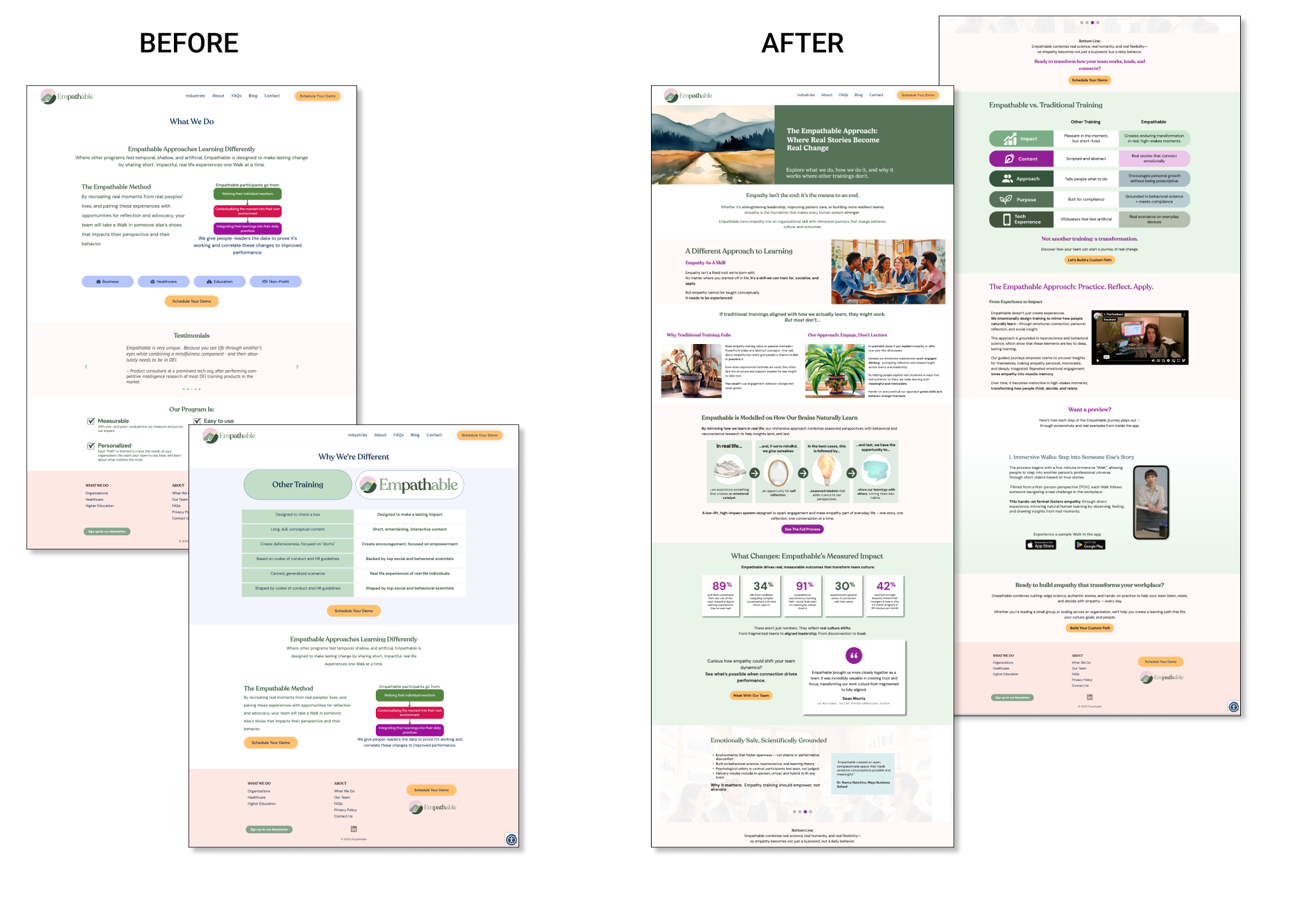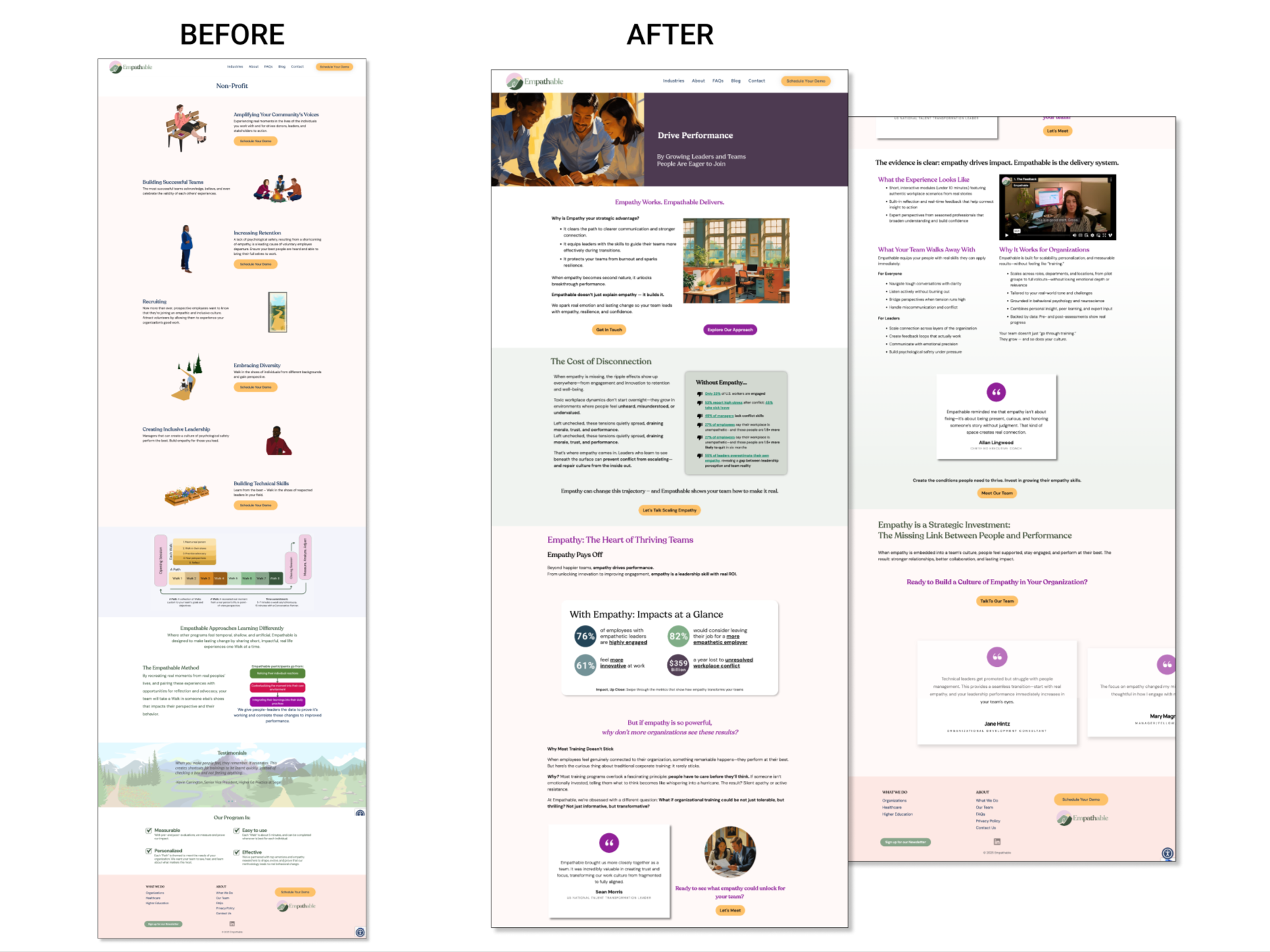Redefining Empathable’s Website
Turning confusion into clarity and growth
At a Glance: Game Highlights
-

Organic Traffic
More visitors reached the site post-redesign, demonstrating broader reach and impact
-

Bounce Rate
Down from 70%+, showing users stayed longer and engaged with the content
-
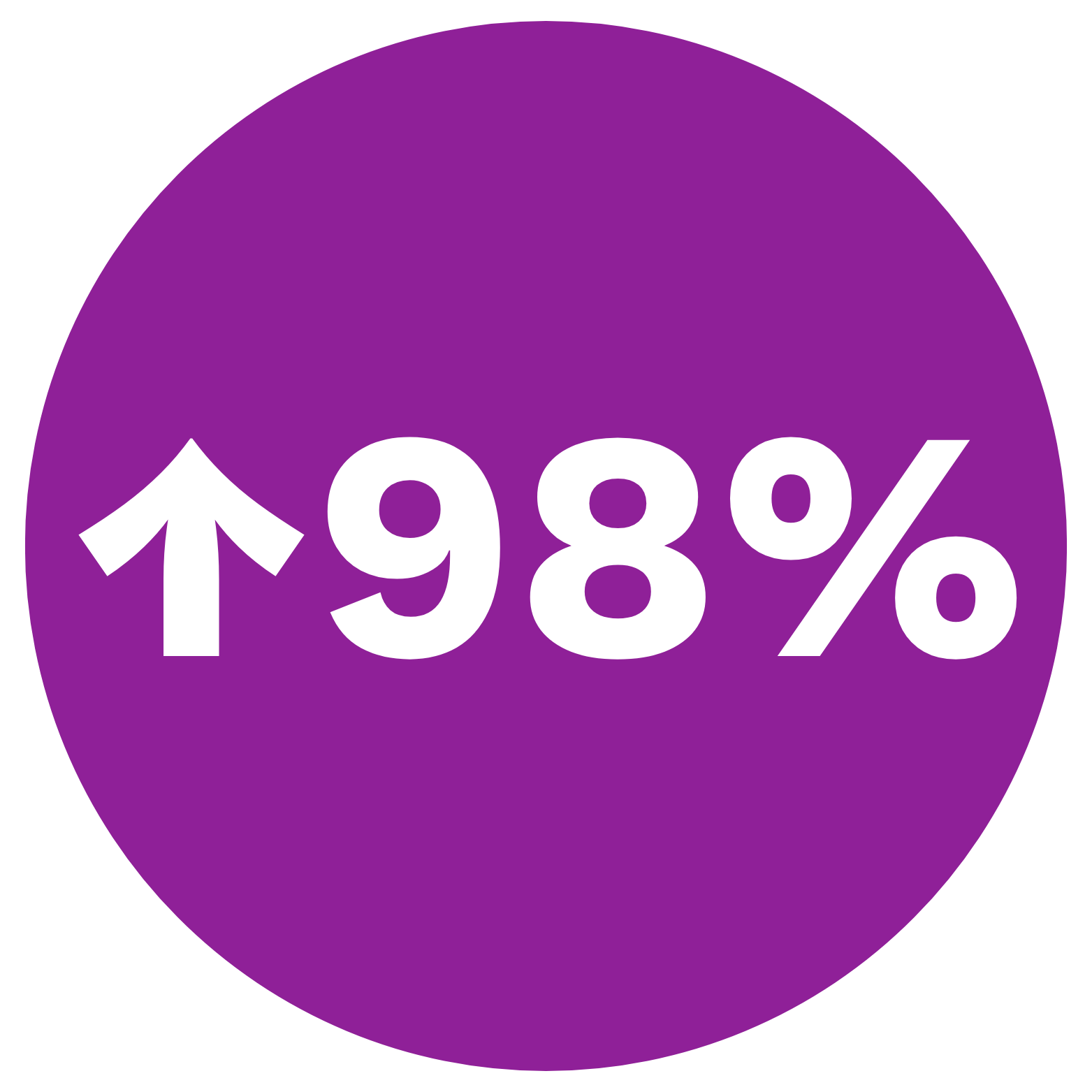
Site Accessibility
Up from 92%, making the site more inclusive and user-friendly
-

Best Practices
Up from 72%, reflecting improved UX quality and modern web standards
-

Role
Lead Product Strategist • Lead UX Copywriter • UX Design Co-Lead
Shaped project strategy, messaging, and UX across multiple audiences and industries, translating research and stakeholder input into actionable content, layouts, and flows.
-

Challenge
The website buried Empathable’s impact.
Visitors often left confused, unable to answer:
What does empathy bring?
Who is it for?
How does it work?
Why Empathable?
This limited engagement and growth. -

Approach
Built vision boards mapping problems → solutions → value propositions to persuade multiple audiences.
Expanded scope to fully address user needs while aligning with business goals.
Crafted outcome-focused copy integrating stories, testimonials, and proof points.
Designed scannable, storytelling-driven layouts: hook → problem → solution → proof → CTA.
-

Impact
Website clearly communicates value across multiple audiences and industries.
Visitors quickly grasp benefits, proof points, and relevance.
Persuasive storytelling guides users from curiosity to action.
Builds trust and drives adoption across audiences.
The Playbook: Step-by-Step Strategy & Execution
Project Overview
Empathable is a B2B empathy training solution trusted by Cisco, Ford, and Harvard-affiliated institutions.
It helps teams lead better, collaborate smarter, and build stronger workplace culture. Delivered mostly through an app, it combines immersive, first-person videos with guided reflections, expert insights, and team discussions.
Empathable’s website is the company’s marketing engine—the first point of contact for potential clients.
I led a redesign that transformed it from fragmented and confusing into a clear, credible platform that communicates value, builds trust, and drives engagement.
My Role
Product Strategist • Lead Copywriter • UX Co-Lead
Strategy & Discovery
Defined project scope and strategy by leading structured discovery, including client workshops and creating vision boards, aligning user needs with business goals across diverse audiences and industries.
UX Copy
Built trust, clarified value, and differentiated Empathable by crafting outcome-driven copy for multiple audiences and industries that simplified multi-steps empathy training content and embedded compelling proof points.
UX Design
Co-led UX architecture, defining page contents, creating intuitive scroll paths, clear content hierarchy, and strategically placed CTA, reducing friction, enhancing clarity, to boost engagement and conversion.
The Challenge
Empathable’s value and credibility were hidden by a confusing website experience, causing buyers to disengage and miss the product’s impact. This gap between product strength and web presence blocked growth, especially in new target sectors.
The Goal
Redesign the site to clearly communicate value, build trust, and drive conversions, measured by reduced bounce, increased demo requests, and enhanced clarity for key audiences.
Pre-Game: Insights, Strategy, Scope
Discovery
To tackle the challenge, we launched a structured discovery phase to explore the product, competitive landscape, and client priorities. Our goal was to identify gaps, surface opportunities, and build the foundation for a strategic redesign grounded in data-driven insights rather than assumptions.
First-time use revealed confusion, confirming gaps in hierarchy, messaging, and visuals.
Key issues included:
Buried value proposition and fragmented copy
Scattered or hard-to-find proof points, weakening credibility
Navigation and content hierarchy that made understanding difficult
Inconsistent visuals that diluted trust
Audit of the Original Site
The client’s brief was straightforward: redo the homepage, expand into healthcare as a growth area, and bring consistency to the visuals. He also asked for a redo of the industry pages, many of which had little content, so they could better speak to each audience.
Clarification of Client Goals
Empathable delivers immersive, app-based empathy training with measurable outcomes—something few competitors can match. Virti (AI/VR simulations) and Enliven Empathy (VR DEI stories) offer related experiences, but the review confirmed Empathable’s unique niche. It highlighted strengths in engagement, scalability, and evidence-based design, while surfacing opportunities to sharpen value messaging for both users and organizations.
Audit of the Competitive Landscape
Example of Original Homepage Issues
The page lacked clear structure and hierarchy, making it hard for users to scan, understand, or follow a logical story.
Visual and content elements didn’t guide attention, leaving the experience fragmented and the product’s value obscured.
Disconnected CTAs
CTAs lack context and guidance, leaving users unsure how to act and breaking the conversion flow.
Ambiguous Hero Section
Users can’t quickly grasp the value proposition. The tagline is unclear: What’s learned? Why real-life experience matters? and the imagery doesn’t reinforce the product’s value.
Messaging & Visual Confusion
Users struggle to understand the offering; vague claims and an unexplained app visual leave them unsure whether Empathable is an app, a service, or both.
Ambiguous Proof Claims
Users can’t assess credibility; industry examples and buttons fail to show outcomes or relevance, leaving users asking what’s being proven and why it matters.
Product Strategy
Redesigning Empathable’s website required more than aesthetics: it had to persuade multiple audiences.
Building on insights from discovery, I led a product strategy phase to deepen understanding of the product and its users, clarify unique value propositions, and align the team on priorities.
I conducted additional research beyond the client’s initial data to ensure our strategy addressed real user and business needs.
Each industry had two audiences to persuade.
Buyers: Needed clear ROI and measurable impact.
End users (employees): Their engagement determined ROI, so addressing their needs was essential to convincing decision-makers.
Dual Audience Challenge
My Approach: Vision Boards
Created dual-audience vision boards to:
Map problems & goals: Identify each audience’s top challenges.
Link problems to solutions: Define value points and competitive advantages.
Reveal unique value propositions: Show why buyers should invest and why users would engage.
Example: Healthcare Vision Boards Insights
Buyers’ goals: Improve patient satisfaction, staff retention, and clinical outcomes.
Staff realities: Heavy workloads, limited time, and gaps in empathy and communication skills.
Interdependence: Buyers’ goals depend on the training delivering real value for staff, improving skills and patient outcomes.
Product value: Practical, time-efficient empathy training that fits staff workflow and delivers measurable impact.
Design impact: Mapping these challenges clarifies which selling points to emphasize and provides a foundation for UX, messaging, and content that engages both audiences effectively.
Outcome
Vision boards guided strategic decisions, informed scope, and reduced iteration in Phase 1.
Phase 1 Scope of Release
Insights from discovery and vision boards revealed that fully addressing user needs required expanding Phase 1 beyond the initial brief, defining deliverables that guided content, design, and visuals for a coherent, persuasive experience.
Deliver immediate clarity and differentiation within 30 seconds, showing measurable impact and practical relevance.
Homepage & Industry Pages
Combine the original What We Do and What Makes Us Different pages into a single page that explains the product, value proposition, and competitive advantages, and includes a trial for the app.
What We Do Page
Anchored in vision board insights: show ROI and outcomes for buyers, while demonstrating staff needs are met to build confidence in adoption.
Messaging
Metrics, testimonials, and client logos to validate credibility.
Proof
Contextual prompts that move buyers from exploration to confident adoption decisions.
CTAs
Game On: Translating Strategy into the Site
Content Strategy
& UX Writing
I shaped Empathable’s messaging to make its multi-step empathy learning solution and nuanced value points clear, approachable, and actionable. The challenge was synthesizing a large volume of information into messaging that worked across multiple pages and audiences.
Synthesized content & strategy: Managed detailed, multi-layered information across the site, simplifying messaging about the product, its value, and measurable outcomes into modular, bite-sized sections that were clear and actionable.
Strategic dual-audience messaging: Balanced two layers of persuasion: empathy upskilling drives ROI for buyers, and Empathable delivers real value for end users.
Guided content journeys: Built a repeatable narrative arc (success → problem → solution → proof → CTA) and adapted flow per page type: general pages (Homepage / What We Do) vs. industry-specific pages (Healthcare, Higher Ed, Enterprise).
Page-level adaptation: Tailored messaging, examples, and proof points—including industry-specific user stories—for each audience while keeping the global framework consistent.
Proof & credibility: Metrics, testimonials, and logos were applied across all scoped pages and adapted to audience context, reinforcing decision-making confidence.
Iterative collaboration: Worked closely with the founder and stakeholders to integrate feedback while maintaining coherent, focused messaging.
Key Responsibilities & Achievements:
Outcome-Focused Homepage Copy
Improved on the original to highlight benefits for each industry and show users immediately what’s in it for them.
BEFORE
Copy was vague and lacked outcomes or relevance, leaving users asking what’s being proven and why the examples mattered.
AFTER
Copy now speaks directly to users with outcome-focused headlines, measurable-impact subheads, industry-specific benefit bullets, and CTAs that guide users to explore how Empathable solves their challenges.
Persuasive Proof and Metrics Copy
Rather than simply asserting product value, we introduced new metrics sections to the What We Do and industry pages to establish credibility and persuade leaders. This example is from the Organization page.
Metrics-driven copy with research-backed, industry-specific proof points. Punchy headlines and curated stats clearly show outcomes and establish credibility, guiding leaders to quickly understand empathy’s measurable impact on their organizations.
Building on the messaging, I co-led the visual strategy to create a user-centered site where information was clear, navigation was intuitive, and key outcomes and proof points stood out. The redesign guided diverse audiences through the homepage, What We Do, and industry pages, helping visitors quickly understand the product, trust its value, and take action.
UX/UI design & Visual Alignment
Key Responsibilities & Achievements:
Multi-audience strategy
Designed layouts to guide buyers and end users across industries, balancing multiple goals across scoped pages.
Content-driven hierarchy
Reinforced the content narrative arc and prioritized key outcomes and proof points for quick comprehension.
Intuitive flow & navigation
Structured pages for easy scanning and seamless action paths.
Unified visual language
Standardized typography, color, icons, and illustrations; recommended real human photos to preserve authenticity and empathy.
Accessibility & performance
Delivered responsive, fast-loading, WCAG-compliant pages; implemented in WordPress and QA-tested for diverse users.
Before & After: Page Transformations
Post-Game: Results and Takeaways
Outcomes & Impact
Guided key actions: Clear content hierarchy and persuasive CTAs led users to explore demos, industry pages, and trial sign-ups.
Boosted engagement: Bounce rate dropped from 70%+ to 51%, showing users stayed longer and consumed more content.
Expanded reach & accessibility: Organic traffic increased, and site accessibility improved from 92% to 98%, making the experience inclusive for all users.
Built credibility & differentiation: Outcome-focused copy, industry-specific proof points, and strategic UX/UI design positioned Empathable as a trusted, performance-enhancing solution across audiences and sectors.
Laid foundation for growth: The redesign created a scalable framework for testing, iteration, and continued optimization.
Final Score
The Empathable redesign proved that strategy, content, and design are inseparable: clarity builds trust, proof drives credibility, and thoughtful UX drives conversion.
By expanding the scope, simplifying complex training content, embedding metrics and testimonials, and iterating across pages, we delivered a coherent, enterprise-ready site that delights users and convinces buyers.
“As our UX designer, strategist and copywriter, Alyssa approached our website project with the kind of passion and dedication that’s rare to find. She didn’t just write copy—she crafted messaging that authentically captured our brand essence while speaking directly to our customers’ mindset. Our website is dramatically better because of Alyssa’s contributions. I wholeheartedly recommend her for any project where you need someone who infuses their work with both professional excellence and genuine care for the people who will experience it.”
Micah J. Kessel, CEO and Founder of Empathable
Next Match: User Research - Fall 2025
Testing With Users
Building on the Phase 1 redesign, Phase 2 will focus on testing and validating the new experience with real users to ensure clarity, engagement, and conversion.
Validate clarity and appeal of messaging, navigation, and visual hierarchy
Test CTA effectiveness, demo conversion, and trust/resonance
Evaluate AI vs. authentic imagery impact
Objectives
Moderated remote usability testing (Zoom/Google Meet) with 9–15 mid-to-senior professionals across healthcare, education, business, nonprofit, and government.
Method
Value clarity, navigation success, demo interest, trust/resonance, content engagement, usability/accessibility barriers.






